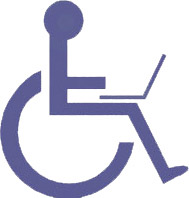 When designing websites, universal accessibility should be a goal you are at least considering. After all, this is the internet. There are users from all walks of life and every culture, and there are also many types of disabilities that your readers might have. This means thinking beyond simple sound capabilities for the benefit of blind individuals, and focusing on a wider cross-section of accessibility options. Here are five important things to consider on behalf of your readers.
When designing websites, universal accessibility should be a goal you are at least considering. After all, this is the internet. There are users from all walks of life and every culture, and there are also many types of disabilities that your readers might have. This means thinking beyond simple sound capabilities for the benefit of blind individuals, and focusing on a wider cross-section of accessibility options. Here are five important things to consider on behalf of your readers.1. Allow Ample Time
If a site is designed as a series of pages with automatic navigation to the next screen, it is important to implement a stop feature. This will allow impaired people who require more time to read a page to do so at their own pace. One example where this would make sense is an online banking site. Of course, we’ve all seen sites that rotate their content too quickly, but ultimately the important thing is to include an element of interactivity that allows readers to set their own pace. The content cycler at Complex Magazine is a good example of something that might technically move too quickly, but easily allows readers to return to any of the features that caught their fancy. Similarly, the top news stories box at Yahoo! is set to cycle slowly through a variety of stories…but that functionality deactivates automatically once the mouse cursor hovers over it, allowing visitors who are clearly interested in reading news stories to assume control of the navigation themselves, on their own terms.
2. Make Content Understandable
Not all people are familiar with certain words. If a particular word is new to a disabled individual, it may be time-consuming and difficult for that person to open a new tab to look up the word. One way to make words more understandable is to provide definition links, which is particularly important if you are working in a specific niche that may not have a universally understood vernacular. A good example of this is Medieval Reader, which focuses on reviews and discussions of medieval literature. As you might expect, a large amount of the events and people they discuss have fallen from public memory, and even basic terms that were common in the 1400s are considered archaic today. Their solution to help new readers understand? Plentiful links to Wikipedia and other sources so that unfamiliar concepts can be explained with a click.
3. Allow For Alternate Input Equipment
Site visitors who have physical disabilities may not be able to use a mouse or keyboard. There are alternate forms of input for such individuals, so sites should be set up to make navigation easy for them. For people who can use a keyboard but not a mouse, make sure keyboard navigation guides are available and easy to see. For a fairly exhaustive itemization of the potential disabilities your visitors might have, check out list from Web Accessibility Guide. It will give you a strong idea of the various barriers to usability that your own website or blog might be inadvertently creating. For concise examples of how these various barriers can be properly avoided or overcome, take a look at the ARISE Web Site’s Accessibility Features. It doesn’t take much to be thorough!
4. Provide Text Alternatives
Videos are popular forms of communication on the web today. However, these videos may not mean anything to deaf individuals. If there are no captions or sign language translations available, be sure to provide the information in a text format. Make sure there is also a version with large print. The Web Axe web design accessibility site has an ongoing feature they call Fixing Alt. Their intention is to track down online comics and humorous macros that, in their original form, were presented without alt text, thus making them unreadable to a large section of disabled readers. Web Axe provides this missing alt text as a free service, and while they could never hope to do this for every comic online, they are doing this to make a point, and to make other bloggers and web designers aware of this need that they are regularly overlooking.
5. Keep Content Steady
Bright flashing signs or colors on a site may grab a visitor's attention, but such features can be very harmful to people who are prone to seizures. As a rule, any large graphic that flashes more than three times per second may cause a seizure. This is also a good rule for designing a pleasant website for any person to browse. Be warned, of course, that what you’ll see at that link is far from pleasant! The difference in “steadiness” is clear within seconds…so is the impact on accessibility.
If you are designing on behalf of a larger company, be sure to discuss universal accessibility options with clients. To learn more about specific guidelines and rules, research the World Wide Web Consortium's Web Accessibility Initiative online, or check out the sites.
If you are designing on behalf of a larger company, be sure to discuss universal accessibility options with clients. To learn more about specific guidelines and rules, research the World Wide Web Consortium's Web Accessibility Initiative online, or check out the sites.














0 comments:
Post a Comment